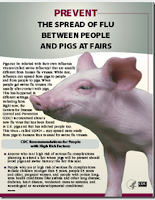#11,641
Between the recent zoonotic transfer of H3N2v to 4 fair-goers in Ohio and Michigan, and a growing number of reports of sick pigs at county fairs (see here & here), swine-origin influenza viruses are making news again.
While local Ag officials have been quick to reassure fair-goers - describing flu infection as both common in pigs and as posing little risk to the public - there are some in the scientific community who are less sanguine on the topic.
In August of 2015 the Journal of Infectious Diseases published a pair of reports warning that exhibition swine pose specific risks for creating novel pathogens with pandemic potential.
Those with good memories may recall I wrote about both of those reports roughly a year ago (see JID: Evolutionary Dynamics Of Influenza A Viruses In US Exhibition Swine). While most of my emphasis was on the study by Nelson et al, the accompanying (open access) editorial is deserving of a closer look.
Not to rain on anybody's parade, but the following excerpt (emphasis mine) sums up the problem pretty well:
Movement of exhibition swine, therefore, may create opportunities for IAV-S to transmit to naive populations and generate novel influenza variants through reassortment. Even though there is evidence of direct transmission of human IAV to exhibition swine, this occurred less often than swine-to-human transmission.
The manners in which these H3N2v viruses have become established in exhibition swine suggest that exhibition swine should be considered a unique reservoir for influenza viruses with pandemic potential.
The full editorial (link below) is well worth reading. When you return, I'll have a bit more.
Influenza A Virus Diversity and Transmission in Exhibition Swine
Articles by Baranovich, T.
Swine are permissive to infections with both avian and human influenza A viruses, facilitating genomic reassortment among viruses from multiple host species. As a result, swine have been identified as mixing vessels for influenza A viruses and a source of emergence for novel viruses, including those with pandemic potential [1, 2]. Since July 2011, human infections with influenza A virus of swine (IAV-S) subtype H3N2 (H3N2v to distinguish them from seasonal H3N2 influenza A viruses) have occurred throughout the United States with more than 340 cases and 1 death (as of July 2015) [3]. The main risk factor for infection with H3N2v was identified as direct contact with swine, primarily during agricultural fairs [4].
There are 3 major swine-human interfaces in the United States: domestic swine (commercial swine and exhibition swine), feral hogs (hunted for sport, food, and animal control), and abattoirs. It is estimated that some 150 million people visit agricultural fairs in North America annually, allowing for considerable contact with live swine [5]. This is more than for any other interface in the United States. Furthermore, agricultural fairs allow for prolonged commingling of pigs from numerous breeders and multiple states.
Collectively, these contacts create an environment conducive to zoonotic transmission, potential for viral reassortment with other strains, and geographic spread of influenza A viruses to new regions. Yet, surveillance, risk assessment, and evolutionary studies of IAV-S at the domestic swine-human interface have been conducted mainly in commercial swine [6–10], and little is known about the diversity of influenza A viruses circulating in exhibition swine. While control measures addressing activities before, during, and after swine exhibitions [11] reduced the infection risk (as demonstrated by the absence of human cases to date in 2015), H3N2v continues to circulate among North American swine and, as such, has high pandemic potential.
(Continue. . . )
None of this is to suggest that the next pandemic virus is on the verge of emerging from your local fair, only that the potential for seeing a novel flu emerge from pigs is real - and that threat is likely exacerbated by the continual mixing and movement of exhibition swine and greater interaction with the public.
A possibility that is not lost on the CDC, as they published a report (under their Flu Spotlight banner) a few days ago on swine flu at county and state fairs, entitled 4 Variant Virus Infections Linked to Pig Exposures.
In it, they advised high risk people to avoid pigs and swine barns at fairs.
A small excerpt (but read the whole thing):
Human infections with a non-human influenza virus should be fully investigated to be sure that such viruses are not spreading in humans in an efficient and ongoing way, and to limit further exposure of humans to infected animals if infected animals are identified. At this time, the epidemiology of the human infections reported this week seems consistent with what has been in the past. None of the most recent infections were hospitalized and there were no deaths. CDC is conducting laboratory studies to find out more about these viruses.(Continue . . . )
Agricultural fairs take place across the United States every year, primarily during the summer months and into early fall. Many fairs have swine exhibitions, where pigs from different places come in close contact with each other and with people. These venues may magnify the risk of spread of influenza viruses between pigs and people.
For more on the evolution of swine viruses, and their pandemic potential, you may wish to revisit:
PNAS: The Pandemic Potential Of Eurasian Avian-like H1N1 (EAH1N1) Swine Influenza
Eurosurveillance: Seroprevalence Of Cross-Reactive Antibodies To Swine H3N2v – Germany
